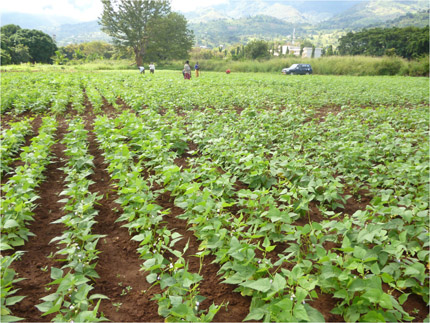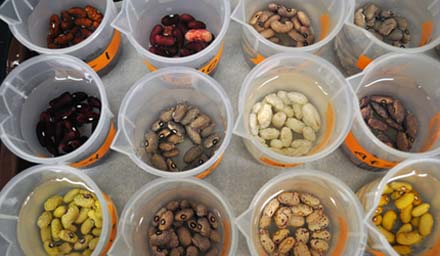5585 Guilford Road • Madison, WI 53711-5801 • 608-273-8080 • Fax 608-273-2021
www.agronomy.org
Twitter | Facebook
NEWS RELEASE
Contact: Hanna Jeske, Associate Director of Marketing and Brand Strategy, 608-268-3972, hjeske@sciencesocieties.org
Andean bean: Small bean for sweet dreams
Jan. 27, 2016 - The story of the Andean bean is, in a way, similar to that of the Princess and the Pea. However, in this tale, the Princess is global food security and the pea is another kind of seed: Andean beans.
In the fairytale, a small lump of a pea keeps the princess awake at night, buried deep under a stack of mattresses. Although she isn’t aware of the pea, the pea has a great impact on her well-being. Likewise, until now, the world hasn’t paid much attention to Andean bean s, but it has the potential to have a huge impact on our well-being. Andean beans have the potential to help us sleep better at night by keeping stomachs full and food growing.
s, but it has the potential to have a huge impact on our well-being. Andean beans have the potential to help us sleep better at night by keeping stomachs full and food growing.
Though not buried under a stack of mattresses, Andean beans (for example, red kidney beans) were overlooked by researchers because other beans were easier to breed. However, Karen Cichy, a research geneticist for the United States Department of Agriculture, and her global partners took notice of the Andean bean. They recognized its potential to play a role in feeding the world.
Cichy explains, “Our goal from the beginning of the project was to improve bean productivity in eastern and southern African countries where beans are a staple of diets.” In order to improve bean productivity, Cichy, Phil Miklas, Tim Porch, and collaborators studied the genetic diversity of Andean beans. They wanted to identify potentially good parental lines for breeding programs.
The researchers started out by collecting 396 Andean bean samples from locations in the United States, Africa, the Caribbean, Canada, and Ecuador. Then, they extracted DNA from the samples and analyzed the DNA looking for gene diversity.
Next, the researchers grew groups of Andean beans in various locations around the globe. In each location, they studied what characteristics the beans displayed and how the bean’s genes interacted with the environment. For example, in Tanzania researchers looked to see how well the beans grew in low-fertility soil. In the state of Washington, researchers studied how well the beans grew in drought conditions. In all, researchers grew beans in five different countries and studied eight different bean characteristics.
Cichy is thrilled with the global teamwork. “It is amazing how quickly progress can be made with collaborators all over Africa, North America, and the Caribbean evaluating the same materials in diverse environments and for diverse traits.”
Information about An dean beans is now in a database. This will provide researchers the genetic information they need to breed better beans more suited to local conditions. For example, farmers struggle with low fertility soil in east Africa, so scientists can use the database information to breed beans that will grow better in low fertility areas. This is welcomed news for small farmers in Africa, and great news for the rest of us as well.
dean beans is now in a database. This will provide researchers the genetic information they need to breed better beans more suited to local conditions. For example, farmers struggle with low fertility soil in east Africa, so scientists can use the database information to breed beans that will grow better in low fertility areas. This is welcomed news for small farmers in Africa, and great news for the rest of us as well.
Andean beans are rich in essential protein, iron, and fiber. They also fix nitrogen into soil while growing, improving the soil for future crops. Cichy and her team’s work on Andean beans may help farmers produce more beans for more people, and feed the world.
Look in Crop Science for more about the team’s findings.
Dried beans and peas are part of a food group known as pulses. The United Nations Food and Agriculture Organization declared 2016 the International Year of Pulses (IYP). In celebration, the Crop Science Society of America (CSSA) created a web page for the public about pulses, www.crops.org/iyp. Special tabs for the public include K-12 Education, Beans in the News, Grown Your Own, and Delicious Ideas. CSSA has also compiled links to various recipes, so you can increase your consumption of pulses.
CSSA will release more information about pulses throughout the 2016 IYP celebration.
Crop Scienceis the flagship journal of the Crop Science Society of America. It is a top international journal in the fields of crop breeding and genetics, crop physiology, and crop production. The journal is a critical outlet for articles describing plant germplasm collections and their use.